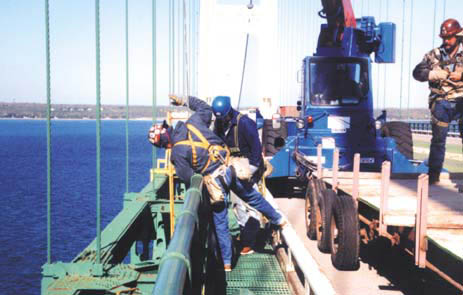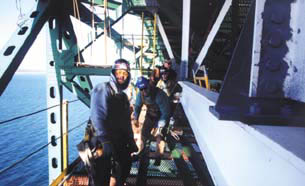Maintenance work by trades helps 'Mighty Mac' stay mighty
Date Posted: November 10 2000
It's a tribute to how well the Mackinac Bridge was built that the span's most expensive renovation project in its 43-year history - scheduled to wrap up this week for the season - has little to do with the integrity or deterioration of the bridge structure itself.
"All in all the structure of the bridge continues to be in excellent shape," said Jim Ecker, chief engineer for the Mackinac Bridge Authority. "It was a very good design." Still, the five-mile long span is constantly exposed to Mother Nature, and maintenance of the bridge is constant, too. That's why prime contractor American Bridge and about 50 iron workers spent a good portion of this year tearing out and replacing the bridge's "travelers," which are essentially moving platforms under various areas of the bridge deck that are used by maintenance workers.
"Basically, the old travelers are shot," Ecker said. "They get stuck, they don't work half the time, and we've been moving parts from one to another to keep them working."
The new, heavier travelers will be powered by diesel engines and will move the platforms along newly installed, beefed-up rails about 15 feet below the bridge deck. "The bridge is going to weigh 800 tons more than when we started," said Dallas Campeau, foreman for the iron workers, who have worked 85,000 man-hours on the project without an injury.
New scissor-lifts and spider stages will be installed in conjunction with the travelers, allowing maintenance workers access to all nooks and crannies of the span.
The $14 million project will be re-started next April and completion could happen as soon as the fall of 2001. Installing the traveler isn't the only project that is going on at Michigan's most famous landmark. Electricians are also re-wiring the bridge, and replacing virtually the entire electrical system, which is original and is starting to fail.
As an apprentice electrician, "Ducky" Nelson of IBEW Local 1070 helped wire the bridge when it was being built, and now he's back over the Straits of Mackinac in 2000 with J. Ranck Electric, helping replace cable, lighting fixtures and related gear.
"It's time," he said. "This stuff is just worn out. The only problem is that you need wings to get at it, everything is underneath the bridge."
Indeed, motorists crossing the Straits don't realize it, but there is a hidden colony of activity going on underneath the bridge deck. The only clues are the yellow access ladders used by tied-off trades workers, who get to them by clambering over the three-foot high guard rail when they go down to work. There are also small cranes on the bridge deck that transport materials to the sub-deck.
There, iron workers toil atop metal mesh staging that has been placed on the bridge's horizontal support beams. When this visitor first got off the ladder and stood on the mesh, there was an assault on the senses. The beautiful view was the first thing I noticed. Looking down through the mesh, the Straits of Mackinac flows by, challenging your sense of balance. Above, traffic can be seen and heard rumbling over the metal road bed in the center of the bridge deck, and heavy vehicles surprisingly make the bridge bounce.
"You get used to it," said iron worker steward Wayne Kirchoff, whose dad worked on the bridge when it was being built. "We're in a pretty exposed position, but we're very conscious about safety on this job. With the wind and the elements you get a good appreciation for what the old-timers had to go through when they built this bridge."
American Bridge was also the prime contractor for the bridge's superstructure when it was built from 1954-57. Five men died during the construction process, but thousands of others lived to tell the tale of how they helped build North America's longest suspension bridge.
"I've been on this bridge a number of times and to me, there's an inspiring sense of history associated with it," said Local 25 Business Agent Larry Sedrowski. "It's a tremendous feeling to be a part of one of the greatest construction projects the world has ever seen."
Throughout the lifetime of the bridge, Ecker said the Mighty Mac has benefited from getting sufficient resources from the state to maintain the span. The structure is constantly being painted from end to end, and inspections for structural integrity are regular and thorough. Two years ago, for the first time in the bridge's history, finger joints and bearings were replaced on the bridge. They allow the bridge to move with the stresses of the wind and traffic.
The structural steel on the bridge is going to have to be replaced, someday, but the regular maintenance performed on the bridge means that won't happen anytime soon. In fact, serious steel replacement isn't scheduled until 2017, when the Mackinac Bridge Authority anticipates replacing the steel grating in the middle of the road and replacement of the underlying deck.
Ecker said the design of the span has withstood the test of time. "There are a few things that could have been done different, but for decades after it was built, builders of suspension bridges copied the design of the Mackinac Bridge."

IRON WORKERS Brian Carmody and Pat Hill await a beam cut out from under the Mackinac Bridge deck. The operator is Mike Ten Eyck of Local 324.

THE WHITE BEAM on the right is part of the new traveling platform that's being installed underneath the Mackinac Bridge. Tearing out iron from the old traveler are iron workers Shaun Wait, Jeff Dishaw and Don Hoffmeyer.
